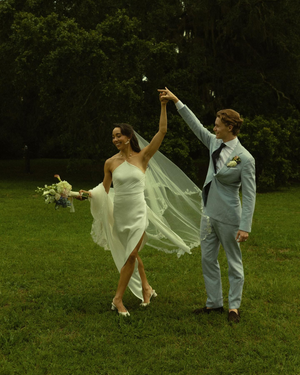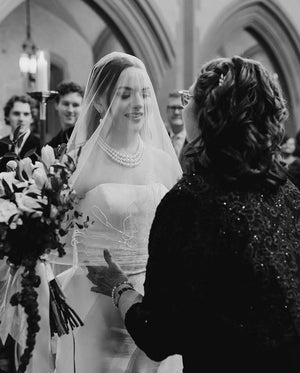You may also like
Eco-friendly veils allow brides to wear something beautiful while supporting sustainable fashion. Fabrics like hemp, organic cotton, bamboo, peace silk and recycled fibres are chosen for their comfort, softness and lower environmental impact. Each fabric carries its own feel, movement and story, making your veil part of a bigger purpose.
In this article, you will find the fabrics that make veils sustainable, what makes each one unique, and how to choose the right option for your wedding day.

Key Qualities of Eco-Friendly Veil Fabrics
When choosing a sustainable veil, below are the main aspects to consider:
Sourcing and Production:
Eco-friendly fabrics come from renewable or responsibly managed sources. Organic cotton and hemp are grown without harmful pesticides, while bamboo regenerates quickly with little water. Peace silk is produced without killing silkworms, offering an ethical option for brides who want luxury without cruelty. Recycled polyester and nylon reduce landfill waste by reusing existing materials.
Environmental Impact:
A veil’s footprint depends on how the fabric is grown, processed, and treated. Fabrics such as hemp and linen require less water and fewer chemicals, making them lower-impact choices. Recycled fibres cut down on plastic pollution and reduce reliance on virgin resources. Choosing fabrics with recognised certifications such as GOTS or OEKO-TEX ensures they meet strict sustainability standards.
Texture and Comfort:
Comfort matters on a long wedding day. Organic cotton and bamboo create soft, breathable fabrics that feel light against the skin. Linen has a firmer texture and drape, offering a bold look, while peace silk provides a smooth, flowing finish. Recycled tulle holds structure well, making it ideal for fuller veils without compromising sustainability.
Durability and Longevity:
Sustainable fabrics are not only eco-conscious but also strong enough to last. Hemp and linen are especially durable, resisting wear and maintaining their structure over time. This durability means veils can be repurposed, passed down, or kept as keepsakes long after the wedding.
Aesthetic and Styling Versatility:
Eco-friendly fabrics vary in drape and appearance, allowing brides to match them with different wedding styles. Peace silk works well for classic, elegant looks, while hemp and linen suit natural or rustic ceremonies. Recycled tulle is versatile, offering volume for modern designs or subtle layers for minimalist styling.
Biodegradability and Afterlife:
Another key quality is how the fabric breaks down over time. Natural fibres such as cotton, silk, hemp, linen, and bamboo are biodegradable, meaning they leave little trace after disposal. While recycled synthetics are not biodegradable, they still extend the life of materials that would otherwise become waste.
Popular Eco-Friendly Fabrics for Veils
When choosing a sustainable veil, consider how the fabric drapes, its origin, and the style it creates. Here are some popular eco-friendly options, each with unique qualities and appeal.
Organic Cotton Tulle
Organic cotton tulle is one of the most accessible sustainable choices for veils. Unlike conventional cotton, it is grown without toxic pesticides or synthetic fertilizers, making it safer for farmers and kinder to the soil. The result is a breathable fabric that feels light and soft against the skin, perfect for brides who want comfort throughout the day. Its airy texture also makes it easy to drape and layer, giving designers freedom to create different silhouettes.
The strength of organic cotton lies in its versatility. It works beautifully for veils with a natural, understated feel, often chosen for rustic, countryside, or outdoor ceremonies. When dyed using eco-conscious methods, the fabric holds color well, though most brides prefer its natural ivory shade for a timeless look. It is also a cost-effective choice compared to luxury silks, making it appealing to brides balancing elegance with affordability.
Another reason many brides choose organic cotton is its durability. Unlike delicate fabrics that snag easily, cotton tulle withstands handling, making it easier to store, alter, or even repurpose after the wedding. Brides who value practicality often see this as a long-term benefit, especially if they hope to pass their veil down or reuse it in some way.
Hemp Fabrics
Hemp is one of the strongest and most sustainable natural fibres available. It requires little water to grow, improves soil health, and matures quickly, which makes it an environmentally responsible option. In fabric form, hemp is known for its durability and unique texture. While it is not as sheer as tulle or silk, its slightly firmer quality gives veils a distinct presence.
For styling, hemp fabrics work best in ceremonies that embrace natural or bohemian themes. Their earthy tone and subtle texture stand out in outdoor weddings, especially when paired with floral crowns or rustic décor. Brides looking for something less conventional often gravitate toward hemp because it projects individuality while still maintaining elegance.
Another benefit is longevity. Hemp softens with use, meaning the fabric grows more comfortable without losing its strength. This quality makes it appealing for brides who value sustainable fashion as a whole, since hemp fabrics can be repurposed long after the wedding. While it may not suit every style of veil, its character makes it an excellent choice for brides who want their veil to feel both sustainable and memorable.
Peace Silk (Ahimsa Silk)
Peace silk, also known as Ahimsa silk, offers brides the beauty of silk without the ethical concerns tied to traditional production. Unlike conventional silk, which requires silkworms to be killed during harvesting, peace silk allows the moths to complete their natural life cycle. This humane method creates a fabric that carries both luxury and compassion.
The texture of peace silk is smooth, with a soft sheen that photographs beautifully. Its natural drape allows veils to flow elegantly, making it suitable for cathedral-length or chapel-length designs. Brides who dream of a classic, romantic look often choose peace silk because it retains all the qualities of traditional silk while reflecting more thoughtful values.
While peace silk is typically more expensive than cotton or recycled fabrics, many brides view the investment as worthwhile. It not only elevates the aesthetic of their wedding attire but also supports a more ethical supply chain. Designers increasingly use peace silk for bespoke veils, giving brides the opportunity to have a piece that feels both luxurious and responsible.
Recycled Polyester or Nylon Tulle
Recycled polyester and nylon are made from post-consumer materials such as plastic bottles or discarded fishing nets. These fabrics help reduce waste while offering a sustainable option for brides who want the structure of tulle without the environmental cost of virgin synthetics. They mimic the look and feel of traditional tulle but carry a lower ecological impact.
A key advantage of recycled tulle is its ability to hold volume and shape. Brides looking for fuller veils with multiple layers often prefer this material because it delivers the same architectural quality as standard synthetics. Its resilience also means it handles embroidery, beading, and other embellishments without losing structure.
For brides focused on modern elegance, recycled polyester and nylon open up many creative possibilities. They allow designers to experiment with length, layering, and edge details, making them suitable for everything from birdcage veils to sweeping cathedral styles. Although not biodegradable, these fabrics give new life to materials that might otherwise pollute oceans or landfills, making them a practical yet stylish choice.

Our Bride: Ami Jarosinski - Minnesota, USA. Photo: Gabrielle Marie. Veil: Lilly - chapel length.
Bamboo Fabric
Bamboo fabric is valued for its natural softness and breathable quality. The plant itself grows rapidly without pesticides, making it one of the most renewable resources available. When spun into fabric, bamboo has a silky texture that feels light on the skin, which is especially appealing for brides who prioritise comfort.
A bamboo veil drapes gracefully, moving easily with the bride and creating a subtle, flowing effect. It is also naturally antibacterial and hypoallergenic, which adds to its appeal for those with sensitive skin. In warm climates or summer weddings, bamboo veils are particularly practical because of their cooling effect.
Styling with bamboo suits brides who want simplicity with a touch of refinement. The fabric’s natural luster works with both minimal gowns and detailed dresses, offering a soft frame without overpowering the look. It can also be dyed in delicate shades, making it adaptable for brides who want a hint of color in their veil.
Linen
Linen, made from flax, is one of the oldest and most sustainable textiles. It requires little water and minimal chemicals to grow, and it biodegrades naturally. Its texture is more structured than cotton, giving veils made from linen a distinctive look. Linen veils tend to carry weight and presence, making them ideal for brides who want a statement piece.
The natural stiffness of linen allows it to hold shape well, which works beautifully in contemporary or unconventional designs. It pairs well with architectural dresses or minimalist gowns, giving a modern edge to bridal styling. Some brides also appreciate the historical significance of linen, as it has long been used in ceremonial garments.
Another quality that sets linen apart is its strength. Unlike more delicate fabrics, linen resists tearing and can last for years, making it suitable for brides who wish to preserve their veil. Its slightly coarse texture softens with time, so it becomes easier to wear without losing character. Linen may not appeal to every bride, but those who appreciate originality often see it as an inspired choice.
Upcycled or Repurposed Fabrics
Upcycling is one of the most personal and meaningful ways to approach a veil. Brides may choose to repurpose heirloom lace, vintage fabric, or even parts of a family wedding dress. This method not only reduces waste but also weaves personal history into the ceremony. A veil made this way becomes a keepsake with emotional depth.
Working with a skilled seamstress is important when creating veils from repurposed fabrics. Some vintage materials may need reinforcement or alteration to match modern styles. However, the result is often one-of-a-kind, carrying a story that no new fabric could replicate.
Upcycled veils also highlight the craftsmanship behind bridal wear. Instead of mass production, they rely on thoughtful design and careful handling of delicate materials. Brides who choose this path often appreciate the sense of heritage and the opportunity to pass down something unique to future generations.
You should know about: Wedding Veil Fabrics Guide 101
Buying Tips for Brides Seeking Sustainable Veils
Ask About Fabric Origins
Start by asking where the fabric comes from. Organic cotton, bamboo, hemp, and peace silk should be sourced from suppliers who use sustainable farming and ethical labor practices. For recycled polyester or nylon, ask if the material comes from verified post-consumer waste streams. Transparency in sourcing is a strong indicator of authenticity.
Check Certifications and Standards
Certifications help confirm that fabrics meet recognized environmental and ethical benchmarks. Labels such as GOTS (Global Organic Textile Standard), OEKO-TEX Standard 100, or Fair Trade show that the material has been independently verified. Brides considering peace silk can look for suppliers who clearly state their commitment to cruelty-free production. These details ensure your veil is more than a marketing claim.
Consider Artisan and Small-Batch Production
Many sustainable veils are crafted by smaller ateliers or independent designers. Supporting these makers not only reduces the carbon footprint of mass production but also helps preserve traditional skills. Handmade veils often carry more individuality and care in finishing, which many brides find meaningful. Asking your designer about their process can give insight into the craftsmanship behind the veil.

Tara Bridal's artisan hand-crafting every details of a floral veil.
Balance Budget With Values
Eco-friendly veils are available at different price points. Organic cotton and recycled fabrics are usually more affordable, while peace silk sits at the higher end. Brides should decide where sustainability fits into their priorities. If budget is limited, consider shorter veil lengths or simpler trims to keep costs manageable without compromising eco-conscious choices.
Look Into Customization Options
Custom work can ensure your veil reflects both your style and sustainability preferences. Some designers specialize in reworking heirloom lace or sourcing reclaimed materials. Others offer embroidery or embellishment with natural or recycled threads. These details allow brides to create something personal while still maintaining eco-friendly principles.
You should know about: The Rise of Customized Veils Among American Brides

TARA Bridal's artisan hand-embroidering motifs on wedding veil
Plan for After the Wedding
Think ahead about what happens once the ceremony is over. A durable fabric such as hemp, linen, or organic cotton can be preserved and passed down. Peace silk and bamboo can be repurposed into smaller keepsakes, while recycled fabrics maintain structure for reuse. Some brides even choose to resell or donate their veil, extending its life beyond a single occasion.
Verify the Brand’s Sustainability Claims
Marketing language can sometimes exaggerate eco-friendly qualities. Take time to research the designer or retailer. Look for detailed information about sourcing, production, and environmental responsibility. Brands that are genuinely committed to sustainability will provide evidence rather than vague claims.
Shop Tara Bridal’s Conscious Veil Designs Online Today!
At Tara Bridal, sustainability and elegance come together in every stitch. Our artisans in Vietnam handcraft each veil with care, using responsible fabrics that carry meaning well beyond the wedding day.
We create veils that brides treasure, made-to-measure to reduce waste and tailored to reflect your vision. With craftsmanship trusted by brides in over 39 countries, Tara Bridal brings together artistry, ethics, and timeless beauty.
Explore Tara Bridal’s sustainable veil collection today and find the best one for your big day.








